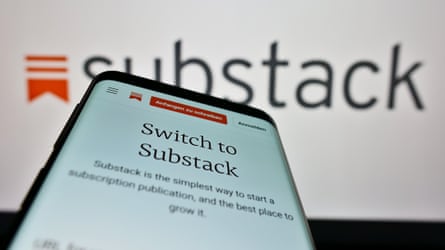The Washington Post has held talks with Substack about hosting pieces by its writers, the site’s co-founder has said, as a host of legacy media brands embrace the newsletter platform in the battle for readers.
In an interview with the Guardian, Substack’s Hamish McKenzie said he had spoken to the Post about its plans to widen the types of opinion pieces on its website.
He said there had been a “change in mindset” from traditional media, which once viewed Substack with suspicion. He said many now saw the platform as an opportunity to adapt to what he described as “the most significant media disruption since the printing press”.
UK news companies including the Daily Mail, the Telegraph and Reach, which publishes the Daily Mirror, have all launched newsletters on Substack.
McKenzie said the Post had approached Substack about hosting its writers. “We’ve talked to them, but there’s no formal agreement or partnership, and they wouldn’t need to talk to us to be able to go out and attempt to do those things,” McKenzie said. “They need to persuade the writers, creators, the journalists, publishers, not us.
“If they’re helping to bring more exposure to those writers and drive audiences to them, if it’s designed in that way – and I’m not 100% sure what the ultimate outcome is going to be – that could be really good for everyone.”
Substack has become increasingly influential since its launch in 2017. It allows anyone to publish and distribute digital content, primarily through newsletters, and charge a subscription. It has also been branching out into podcasts and video.
The potential tie-up comes after Jeff Bezos, the billionaire owner of the Post, provoked its comment editor to walk out after he announced its comment pages would be more narrowly focused on pieces that supported and defended “personal liberties” and “free markets”. The move was seen as an attempt by Bezos to safeguard his relationship with President Trump.
However, the Post – under its British chief executive and publisher, Will Lewis – is trying to find other ways of drawing in readers following reported losses of $100m (£74m) last year, including a project to host comment pieces from other sources on its website.
Reach has launched dozens of Substacks this year alone, covering topics from book trends to Liverpool FC. The Telegraph has just started to post content on a royal family Substack, while the Daily Mail has a Substack dedicated to showbiz news.
“All of a sudden really, a bunch of legacy news organisations are trying to see how they can take advantage of Substack,” McKenzie said. “That’s a really welcome change in mindset. At first people looked at us as if we were a curious instrument and then they started to look at us as maybe we were a threat, because some talent would prefer to go independent on Substack rather than be in a newsroom.
“People are starting to understand that Substack is not just a publishing system that helps people make money, but it’s also a network and it represents new land to build on, where new media products can be born and built. Legacy institutions can build those just as well as newcomers. It’s a big opportunity era.”
He said Substack was supposed to be a “disruptor of social media”, rather than the traditional media, allowing longer writing instead of viral content. He said he had “no regrets whatsoever” about having resisted overtures from Elon Musk to buy the site.
McKenzie said Substack was trying to find new workable models for media amid the struggles of traditional outlets to hold on to rapidly fragmenting audiences. “It’s not a problem with demand for quality journalism,” he said. “It’s a problem with the business model and so there has to be a reinvention. We’re almost at the point where the fire has razed through the forest and there are a few trees still standing. It’s time to replant the forest. We’re living through the most significant media disruption since the printing press.”

What is Substack?
Substack allows anyone to create digital content, which then sits on a dedicated website and can be sent directly to the inboxes of subscribers. It has also branched out into audio and video features in an attempt to benefit from the podcast boom. Crucially, it allows writers to charge a subscription for some or all of their pieces.
The ability to monetise content has allowed some established writers to break away from traditional titles and go it alone. According to an analysis by the Press Gazette, the number of Substack newsletters with at least $500,000 (£369,000) in annual subscriptions revenue alone has doubled in two years. Some of the writers on the site have become influential in US politics, including Bari Weiss and Matt Yglesias.
In the UK, it has provided a platform for new local news sites where newspapers have disappeared from the map or had their reporting staff significantly cut back. New ventures include The Manchester Mill, launched by the journalist Joshi Herrmann, and London Centric, launched by the former Guardian journalist, Jim Waterson.

 13 hours ago
8
13 hours ago
8

















































